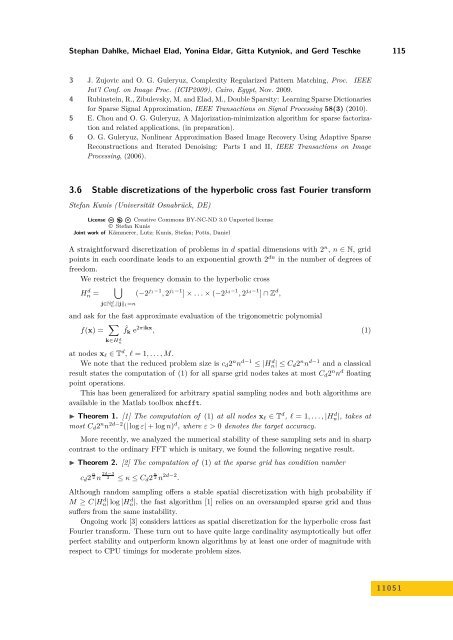Volume 1, Issue 1, January 2011 - DROPS - Schloss Dagstuhl
Volume 1, Issue 1, January 2011 - DROPS - Schloss Dagstuhl
Volume 1, Issue 1, January 2011 - DROPS - Schloss Dagstuhl
Create successful ePaper yourself
Turn your PDF publications into a flip-book with our unique Google optimized e-Paper software.
Stephan Dahlke, Michael Elad, Yonina Eldar, Gitta Kutyniok, and Gerd Teschke 115<br />
3 J. Zujovic and O. G. Guleryuz, Complexity Regularized Pattern Matching, Proc. IEEE<br />
Int’l Conf. on Image Proc. (ICIP2009), Cairo, Egypt, Nov. 2009.<br />
4 Rubinstein, R., Zibulevsky, M. and Elad, M., Double Sparsity: Learning Sparse Dictionaries<br />
for Sparse Signal Approximation, IEEE Transactions on Signal Processing 58(3) (2010).<br />
5 E. Chou and O. G. Guleryuz, A Majorization-minimization algorithm for sparse factorization<br />
and related applications, (in preparation).<br />
6 O. G. Guleryuz, Nonlinear Approximation Based Image Recovery Using Adaptive Sparse<br />
Reconstructions and Iterated Denoising: Parts I and II, IEEE Transactions on Image<br />
Processing, (2006).<br />
3.6 Stable discretizations of the hyperbolic cross fast Fourier transform<br />
Stefan Kunis (Universität Osnabrück, DE)<br />
License Creative Commons BY-NC-ND 3.0 Unported license<br />
© Stefan Kunis<br />
Joint work of Kämmerer, Lutz; Kunis, Stefan; Potts, Daniel<br />
A straightforward discretization of problems in d spatial dimensions with 2 n , n ∈ N, grid<br />
points in each coordinate leads to an exponential growth 2 dn in the number of degrees of<br />
freedom.<br />
We restrict the frequency domain to the hyperbolic cross<br />
�<br />
H d n =<br />
j∈N d 0 ,�j�1=n<br />
(−2 j1−1 , 2 j1−1 ] × . . . × (−2 jd−1 , 2 jd−1 ] ∩ Z d ,<br />
and ask for the fast approximate evaluation of the trigonometric polynomial<br />
f(x) = �<br />
ˆfk e 2πikx , (1)<br />
k∈H d n<br />
at nodes xℓ ∈ T d , ℓ = 1, . . . , M.<br />
We note that the reduced problem size is cd2 n n d−1 ≤ |H d n| ≤ Cd2 n n d−1 and a classical<br />
result states the computation of (1) for all sparse grid nodes takes at most Cd2 n n d floating<br />
point operations.<br />
This has been generalized for arbitrary spatial sampling nodes and both algorithms are<br />
available in the Matlab toolbox nhcfft.<br />
◮ Theorem 1. [1] The computation of (1) at all nodes xℓ ∈ T d , ℓ = 1, . . . , |H d n|, takes at<br />
most Cd2 n n 2d−2 (| log ε| + log n) d , where ε > 0 denotes the target accuracy.<br />
More recently, we analyzed the numerical stability of these sampling sets and in sharp<br />
contrast to the ordinary FFT which is unitary, we found the following negative result.<br />
◮ Theorem 2. [2] The computation of (1) at the sparse grid has condition number<br />
cd2 n<br />
2 n 2d−3<br />
2 ≤ κ ≤ Cd2 n<br />
2 n 2d−2 .<br />
Although random sampling offers a stable spatial discretization with high probability if<br />
M ≥ C|H d n| log |H d n|, the fast algorithm [1] relies on an oversampled sparse grid and thus<br />
suffers from the same instability.<br />
Ongoing work [3] considers lattices as spatial discretization for the hyperbolic cross fast<br />
Fourier transform. These turn out to have quite large cardinality asymptotically but offer<br />
perfect stability and outperform known algorithms by at least one order of magnitude with<br />
respect to CPU timings for moderate problem sizes.<br />
1 1 0 5 1













